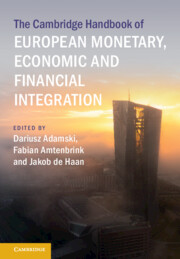Book contents
- The Cambridge Handbook of European Monetary, Economic and Financial Integration
- The Cambridge Handbook of European Monetary, Economic and Financial Integration
- Copyright page
- Contents
- Contributors
- Introduction
- Part I The Economic and Monetary Union
- Part II The Monetary Dimension
- Part III The Economic and Fiscal Dimensions
- Part IV Financial Integration
- 23 Banking Regulation in Europe
- 24 The Politics behind the Creation of the Banking Union
- 25 Failing Banks within the Banking Union at the Crossroads
- 26 The Banking Union
- 27 The Re-emergence of Market-Based Finance?
- 28 The European Strategy on Digital Finance and Its Interplay with Capital Markets Integration in the EU
- 29 Regulating Crypto and Cyberware in the EU
- Index
- References
28 - The European Strategy on Digital Finance and Its Interplay with Capital Markets Integration in the EU
from Part IV - Financial Integration
Published online by Cambridge University Press: 28 September 2023
- The Cambridge Handbook of European Monetary, Economic and Financial Integration
- The Cambridge Handbook of European Monetary, Economic and Financial Integration
- Copyright page
- Contents
- Contributors
- Introduction
- Part I The Economic and Monetary Union
- Part II The Monetary Dimension
- Part III The Economic and Fiscal Dimensions
- Part IV Financial Integration
- 23 Banking Regulation in Europe
- 24 The Politics behind the Creation of the Banking Union
- 25 Failing Banks within the Banking Union at the Crossroads
- 26 The Banking Union
- 27 The Re-emergence of Market-Based Finance?
- 28 The European Strategy on Digital Finance and Its Interplay with Capital Markets Integration in the EU
- 29 Regulating Crypto and Cyberware in the EU
- Index
- References
Summary
This chapter focuses on the historical path and the impact of digital finance policies on capital markets integration in the European Union. The first section gives an overview of the origins of key recent technological developments for the financial system, such as distributed ledger technologies, and the principle of regulatory intervention in the EU. The second section delves into the content of the most recent European strategy on digital finance, with a focus on recent regulatory interventions, such as the Markets in Crypto Assets Regulation (MiCAR) and the Distributed Ledger Technology Regulation (DLTR). The last section draws conclusions on the promises and perils of a digital security for capital markets integration and corporate governance.
- Type
- Chapter
- Information
- Publisher: Cambridge University PressPrint publication year: 2023



